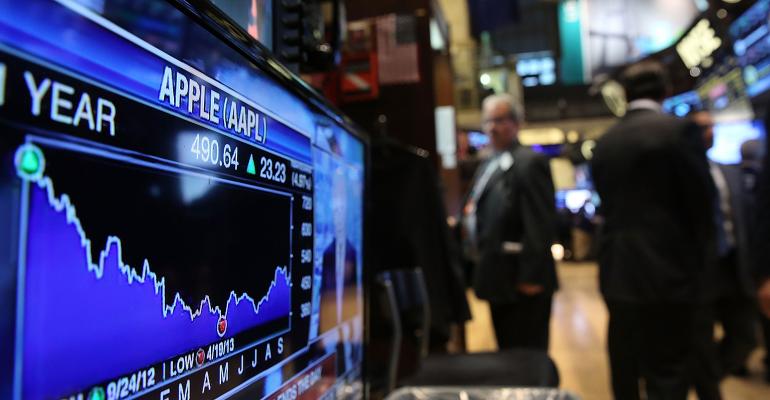By Barry Ritholtz
(Bloomberg View) --I was intrigued by Jeff Sommer’s column in the Sunday New York Times business section with the headline, “The Best Investment Since 1926? Apple.”
As the headline indicated, “Apple has generated more profit for investors than any other American company.” At this time last year over that roughly 90-year period, the leader was Exxon Mobil Corp. Note that the oil giant has been publicly traded almost three times as long as Apple Inc.
Amazon.com Inc.’s annualized returns were the highest, at 37.4 percent, but it hasn’t been in existence long enough to create as much investor wealth; it ranked 14th on the list, which was created by Hendrik Bessembinder, finance professor at the W.P. Carey School of Business at Arizona State University. Other notable companies on the list include Facebook Inc., Visa Inc., Alphabet Inc. (Google), Microsoft Corp. and Berkshire Hathaway Inc.
But the column is also filled with several broad data points that are even more provocative:
Only 4 percent of all publicly traded stocks account for all of the net wealth earned by investors in the stock market since 1926, he has found. A mere 30 stocks account for 30 percent of the net wealth generated by stocks in that long period, and 50 stocks account for 40 percent of the net wealth.
Let that sink in a moment: Only one in 25 companies are responsible for all stock market gains. The other 24 of 25 stocks -- that’s 96 percent -- are essentially worthless ballast.
Therein lies the rub. Buried within that data point is the implied question all of investment management has been wrestling with since, well, forever: “How can investors find the top-performing stocks like Apple, Amazon and Exxon Mobil?”
More recently, the follow-up question has become, “And should they even bother trying?”
There are several ways an investor can own these winners, all of which fall into one of two categories: inclusivity and exclusivity.
The exclusive approach is to carefully screen and research every company that is publicly traded to home in on those rare outsized winners. Exclude everything else, own (what you hope is) are the best of the best stocks.
The inclusive approach is the opposite: buy just about every stock, thereby ensuring that you will own the big winners, as well as lots of mediocre performers and plenty of outright losers. This keeps your costs low, and time works in your favor. Eventually, winners push aside the losers, as they accumulate market capitalization-weighted size.
Each approach has its advantages and disadvantages. Their merits have been driving the debate over active versus passive investing, and alpha versus beta. Other approaches to inclusive-exclusive screening include factor investing and smart beta.
There are challenges.
The exclusive approach requires that a number of low-probability events break your way as an investor. First, you must develop a methodology that allows you to identify those rare companies that will generate outsized returns over time. At the same time, you must be able to avoid the various value traps and other false starts. These pitfalls historically have worked wonders at separating investors from their money.
Next, there is an implied question built into the first: Once you actually find these rare companies, you have to hold on to them. This too is much more challenging than most realize. The stellar stocks tend to have regular, gut-wrenching price slumps; the big winners above have all suffered retreats of 50, 60 even 90 percent on the way to becoming the biggest winners. Most investors lack the fortitude and discipline to manage the pain of these severe price fluctuations.
Once you get through those two challenges, you have to decide when to jettison these winners since nothing continues forever. As Sommer points out, General Motors Co. was a star from 1926 on -- that is, until it went bankrupt in June 2009 and basically wiped out equity investors. AT&T Inc., meanwhile, was broken into many smaller parts, some of which have done very well (Verizon Communications Inc.), while others not so much (Lucent).
As we have observed repeatedly, finding the very best companies to own is very difficult to do.
The inclusive approach has its challenges as well. Indexing is boring, and it gives you nothing to talk about at parties. It is considered a lazy way of investing, even un-American and antithetical to capitalism -- or worse.
But it does have two undeniable advantages for those hunting for the market’s biggest winners: First, it’s much less expensive, and second, it is guaranteed to work.
Think about that the next time you wistfully look at Amazon’s stock price.
This column does not necessarily reflect the opinion of the editorial board or Bloomberg LP and its owners.
Barry Ritholtz is a Bloomberg View columnist. He founded Ritholtz Wealth Management and was chief executive and director of equity research at FusionIQ, a quantitative research firm. He blogs at the Big Picture and is the author of “Bailout Nation: How Greed and Easy Money Corrupted Wall Street and Shook the World Economy.”
To contact the author of this story: Barry Ritholtz at [email protected] To contact the editor responsible for this story: James Greiff at [email protected]
For more columns from Bloomberg View, visit bloomberg.com/view

